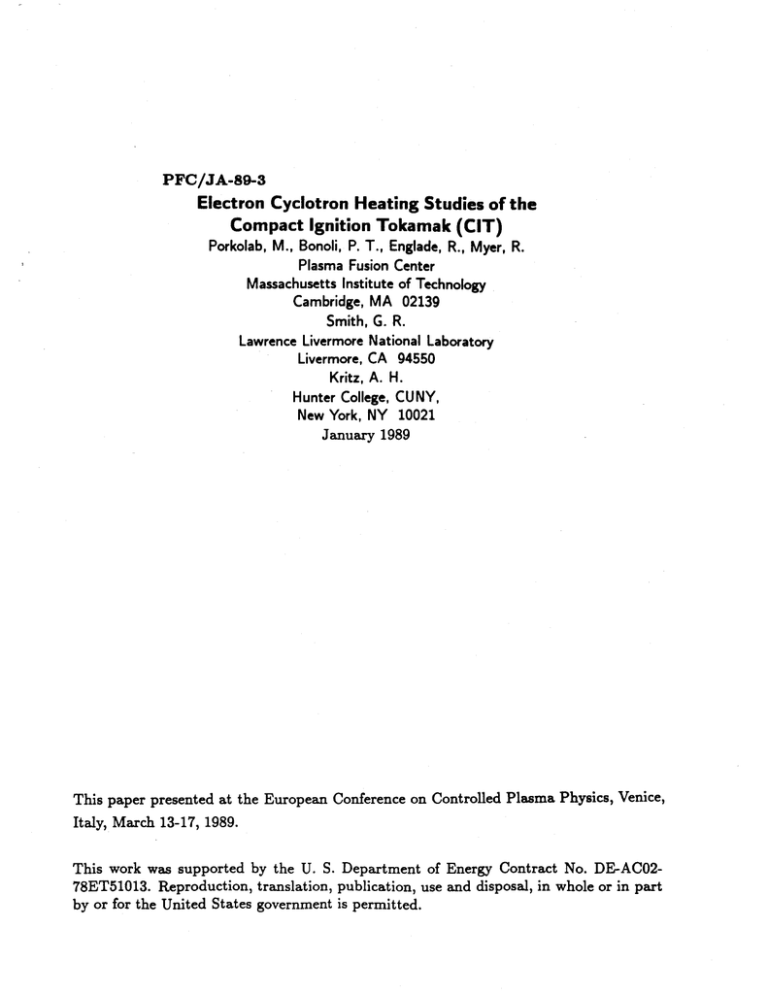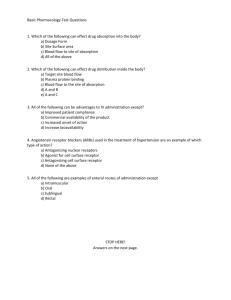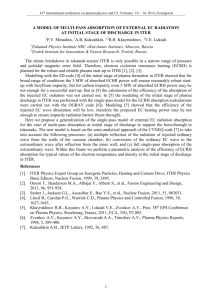Electron Cyclotron Heating Studies of the
advertisement

PFC/JA-89-3 Electron Cyclotron Heating Studies of the Compact Ignition Tokamak (CIT) Porkolab, M., Bonoli, P. T., Englade, R., Myer, R. Plasma Fusion Center Massachusetts Institute of Technology Cambridge, MA 02139 Smith, G. R. Lawrence Livermore National Laboratory Livermore, CA 94550 Kritz, A. H. Hunter College, CUNY, New York, NY 10021 January 1989 This paper presented at the European Conference on Controlled Plasma Physics, Venice, Italy, March 13-17, 1989. This work was supported by the U. S. Department of Energy Contract No. DE-AC0278ET51013. Reproduction, translation, publication, use and disposal, in whole or in part by or for the United States government is permitted. ELECTRON CYCLOTRON TOKAMAK(CIT) HEATING STUDIES OF THE COMPACT IGNITION M. Porkolab, P. T. Bonoli, R. Englade and R. Myer PLASMA FUSION CENTER, MIT, Cambridge, MA 02139 USA G. R. Smith, LLNL, Livermore, CA 94550 USA A. H. Kritz, Hunter College, CUNY, New York, NY 10021 USA I. Introduction The Compact Ignition Tokamak (CIT) operating scenario calls for ramping the toroidal magnetic field from BT = 7.0 (8.0) to 10.0 Tesla in a few seconds, followed by a burn cycle and a ramp-down cycle. Simultaneously, the plasma must be heated from an initial low beta equilibrium (3 ~ 0.44% at 7.0 to 8.0 Tesla) to a final burn equilibrium ( = 2.8%) having 10.0 Tesla on the magnetic axis [1]. Since the toroidal plasma current will be ramped at the same time and since the available time for flat-top magnetic field must be reserved for the burn cycle, it is imperative that densification and heating be carried out as the magnetic field is ramped. Here we examine an approach which is applicable to ECR heating. The frequency remains constant, while the angle of injection is varied by simply rotating a reflecting mirror placed in the path of the incident microwave beam. The rotating mirror permits one to launch waves with sufficiently high N11 so that the Doppler broadened resonance of particles on the magnetic axis with f = 280 GHz and BT = 7.0 - 8.0 Tesla can provide adequate absorption [2]. As the resonance layer moves toward the magnetic axis the beam is swept toward perpendicular to reduce the Doppler width and avoid heating the plasma edge. At BT = 10.0 Tesla the beam will be at normal incidence with strong absorption immediately on the high field side of the resonance (relativistic regime) [3]. We envisage using the ordinary mode (0-mode, ERp 11 j) of polarization which is accessible from the outside (low-field side) of the torus provided the density is such that w,, ! w t we, (max). Considering f = 280 GHz for central heating at B(0) = 10.OT, the maximum cutoff density is.at n,t ; 9.7 x 102Om- 3 which is above the maximum central density in CIT. We note that recent advances in source technology (gyrotrons and FELs) make ECR heating of CIT at 280 GHz a viable option. Equilibration of temperature between electrons and ions (rQ) is expected to be significantly shorter than typical energy confinement times, -rE. For example, at n, a 2.0 x 10 20 m-3 , T. = 5 keV, Zff ~ 1.5, we estimate rEQ t 30 msec, while at n.(0) $ 8 x 10 2 0 m-3 , T, z Ti z 20 keV, rEQ ~ 60 msec, both significantly shorter than the expected energy confinement time. II. Ray Tracing Results Here we study single pass absorption of waves in equilibria representative of the CIT plasma. In terms of a normalized poloidal flux 0, the temperature and density profiles are taken to be T.(O) = T. (0)[1 - tk] and n. (tk) = n. (0)[1 - tk]. The ray tracing and absorption simulation was performed using the Toroidal Ray Tracing, Current Drive and Heating Code (TORCH) developed by Smith and Kritz[4]. We first present the results of ray tracing calculations for the nonresonant magnetic field of B(0) = 7.5T in the Doppler regime. In Figures 1 (a,b) we show cases of wave penetration and absorption for BT = 7.5 T, 0 = 30*, T.(0) =5, 10 keV and n.(0) = (2.2 and 1) x10 20 m- 3 , respectively. The large dots shown in these figures represent the locations where the power in each ray decreases by 20%. We find 100% single pass absorption for T,(0) > 5.0 keV, with absorption peaking at r/a ~ 0.3 at T.(0) = 5.0 keV, and r/a ' 0.2 at T. ' 10 keV. Notice that the half width of the absorption layer is typically ,Ar ~ 10 cm. We find that relativistic effects (which are included 1 in this code) shift the absorption toward the cyclotron resonance layer by amounts dr ' 10 cm. Since the width of the particle resonance and the location of maximum absorption in the Doppler regime is directly proportional to N11, the power deposition profile can be controlled by changing the incident wave propagation angle. We find that for the 7.5 Tesla case, the optimum angle is approximately 30* to the normal. For BT = 7.0 T, the absorption shifts far to the high field side of the plasma column, whereas for BT > 7.5 T, the absorption shifts toward the low field side. In order to keep the absorption close to the magnetic axis as the beta and magnetic fields are increasing during the ramp-up, we find that the angle must be swept toward normal incidence at BT = 10.0 Tesla. This ensures wave penetration to the center at full field and beta (relativistic regime, N < (T./mec')I) [3]. While strong offaxis absorption may be appropriate in a burning plasma for controlling MED activity, in the low beta regime central heating may be preferable. Typical results of power deposition at BT = 10 T, 0 = 10*, T. = 10 keV are shown in Figure 1(c). As we see, central wave penetration and absorption occurs at 0 < 10*. For normal incidence (0 = 0), complete wave absorption results in a few centimeter radial distance beyond the cyclotron resonance layer. This gives us confidence that these waves can penetrate to the core of even a burning plasma (n.(0) , 8 x 10 20 m-3 , T.(0) ~ 20 keV), and be absorbed near the center. The efficiency of coupling to the O-mode at the edge of the plasma as a function of the angle of incidence has been calculated, and the result is P0 (1 + sina202 PTT~)4 1+c+ +osCO20 s , (1) where /3 = w,./w 2 and r7 = (sin4 0+4 cos 2 0/0)f. For nonresonant heating (BT > 7 T, 0 < 30*), Eq. 1 predicts that at least 68% of the power injected will couple to the 0-mode at the edge. We have also examined the importance of scattering of EC rays by low frequency density fluctuations [53, and find that for < 6n./n, > < 0.1, scattering is not important. III. Transport Code Simulations A version of the combined equilibrium and transport code BALDUR1-1/2D originally developed by G. Bateman [6] has been used to simulate some important aspects of the ECH heating scenario for CIT. In our initial investigations, we have held constant the total plasma current, toroidal field, and parabolic particle density proffle, and followed the time evolution of the electron and ion temperature distributions. We have assumed that the electron heat flux can be written as q. = -Mx.VT,-(M - 1)aCrTT.VV/V(a) (conduction and inward heat pinch), with r, = [CI(p)V 2 (a)A-/ 2 /T,(p)VV 2 ][1 + 70(1 - POH/PTOT)2 < j3 p > [7, 8]. Here p is a flux surface label, I, is the current within p, A is the total cross-sectional area, V = V(p) is the volume within p, p = a designates the plasma boundary, and aT describes a "canonical" profile shape T, cK exp(-aTV/V(a)) which the transport model seeks to enforce. The constant C is chosen to fit low density Ohmic experiments, and -to ~ 5(10) reproduces H(L-) mode experimental results with auxiliary heating. We have taken aT = 3.33 and M = 3. Ion thermal transport is assumed to be 0.5 times that of the electrons in addition to a neoclassical contribution. ECH absorption per unit volume by electrons is represented by the form P(p) = Poexp[-(z - _0)2/225], where x(p) is the half-width in cm of a flux surface in the meridian plane, zo designates the location of maximum absorption, and Po is proportional to the total power launched in the 0-mode. We note that our transport implies an essentially offset linear dependence of the total plasma energy on total input power, W~ a + bP. It is thus more optimistic for ignition than 2 empirical scalings such as Kaye-Goldston or Goldston which have been obtained by assuming W oc P* with a < 1. In Figure 2(a) we show the time development of the central temperatures when 10 MW of ECH is input for 3 seconds into an ohmic target plasma with BT = 7.5 T, I, = 8 MA, Zff = 1.5, and n,(O) = 2.2 x 102Om- 3 . In agreement with ray tracing results, maximum absorption is taken one third of the way out from the magnetic axis. Here we have assumed H-mode (auxiliary) confinement and no sawteeth. Figure 2(b) illustrates the same case with a sawtooth repetition time of 0.3 sec. The plasma does not ignite because of the low density used in the simulations. For L-mode confinement and no sawteeth, T, and T saturate at 14 keV and 12 keV, respectively. Shifting the location of maximum absorption to the magnetic axis results in a 40% enhancement of central electron temperatures, but the ion temperatures remain similar for the above cases. Neglecting the inward pinch term in the heat transport model (M -+ 1) has little effect for the off-axis cases, but enhances electron and ion temperatures by 100% and 50% respectively for on-axis heating. We have also investigated the behavior of a high density (n,(0) = 6.6 x 10 2 0m- 3 ) CIT plasma with BT = 10 T, I, = 10 MA, and Zf f = 1.5 when ECH absorption peaks at the magnetic axis. For the case of 10 MW input power, H-mode confinement, 1.5 sec. pulse length, and no sawteeth (Figure 3(a)), ignition occurs with < / > = 1.3% and rT = 0.9 sec. Sawteeth with a 0.3 sec. repetition time prevent ignition at the 10 MW power level, but not at 17 MW. Lowering the power to 5 MW, ignition conditions are again achieved after a 3 sec. RF pulse length with H-mode confinement and no sawteeth (Figure 3(b)). Finally, using L-mode confinement, ignition is obtained with 17 MW of input power applied for 3 sec. (rE = 0.6 sec., < # > = 2.2%). For a flatter density profile (n(t)/n(0) ~ (1 - 1p) 1/2 ), n(Q) = 6.6 x 1020 m- 3 , and L-mode confinement, PRp ;t 25 MW is required for ignition within 3 sec. at < / > = 2.8%, and rE = 0.6 sec. We note that under the above conditions TGodt. TK.y. < 0.40 sec., < 0.27 sec. and for the latter, ignition would not occur. Figure Captions Fig. 1. ECH ray trajectories. Each dot represents 20% power absorption. a) BT = 7.5 T, 6 =30*, T. = 5 keV; b) BT = 7.5 T, 9 = 30*, T. = 10 keV; c) BT = 10 T, 6 =10*, T, = 10 keV. Fig. 2. CIT discharge evolution for n.(0) = 2.2 x10 20 m- 3 . PRF = 10 MW, deposited at ro/a = 0.3, AtRF = 3 sec., H-mode confinement a) without sawteeth; b) with sawteeth, r,,.= 0.3 sec. Fig. 3. CIT discharge evolution for n,(0) = 6.6 x102Om- 3 , on-axis deposition, H-mode confinement, no sawteeth; a) PRF = 10 MW, AtRF = 1.5 sec.; b) P"u = 5 MW, AtpRp = 3 sec. References [1] R. Parker, et al., paper IAEA-CN-50/J-I-1, presented at the 12th Int. Conf. on Plasma Physics and Contr. Nuclear Fusion Research, Nice, France, October 12-19, 1988. [2] R. Myer, M. Porkolab, G. R. Smith, A. H. Kritz, MIT PFC/JA-89-2 (1989). [3] M. Bornatici, R. Cano, 0. DeBarbieri, and F. Engelmann, Nuclear Fusion 23, (1983) 1153. [4] G. R. Smith, W. Nevins, R. Cohen, A. Kritz, Bull. Am. Phys. Soc. 31, (1986) 1516. [5] E. Ott, B. Hui, K. R. Chu, Phys. Fluids, 23, (1980) 1031. [6] G. Bateman, Spring College on Plasma Physics, Theste, Italy (1985). [7] B. Coppi, Fizica Plazmy 11, (1985) 83. Also: MIT Report PTP-85-16 (1985). [8] R. Englade, MIT Report PTP-87-12 (1987). 3 (a) (b) I 9j 1001- -sI. 9 91 1oo0 I, / (c) 'I '9 I I * 5 i0oot ---- I I I '9 9~ S S I E I S SI S OF U 0III I I, 9 If I''I I 'I -100- H - I' I 150 1 200 2 250 5 200 - S I I 250 2 ISO 200 I 250 R (cm) 25 20 20 I- / / 's--i- i Fig, 1 0 I I 5 - I 150 * * . -100|- I 9 5--- S9I S9I S /J Il 'I -100 F ~ S S SI 9 15 15r 0 10 - Te 10 -v~ I.- T 5 5 I~b~ 1 Fig. 2(a) 5 4 3 2 6 0- t (sec) 1 2 4 Fig. 2(b) t(sec) 1 5 6 I 50 40 Ic 30 T 20 5 i - 10 1 2 Fig. 3(a) 3 t(sec) 4 5 C 1 2 Fig. 3(b) 3 4 t(sec) 5 6







